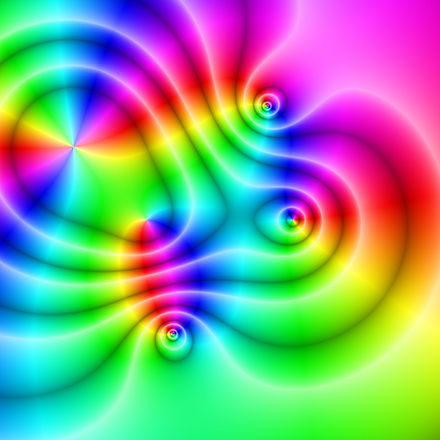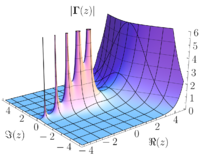Эта статья включает в себя список литературы , связанной литературы или внешних ссылок , но ее источники остаются неясными, поскольку в ней отсутствуют встроенные цитаты . ( Март 2021 г. ) ( Узнайте, как и когда удалить этот шаблон сообщения ) |

Оттенок представляет аргумент , яркость - величину.
| Математический анализ → Комплексный анализ |
| Комплексный анализ |
|---|
 |
| Комплексные числа |
| Сложные функции |
| Основная теория |
| Геометрическая теория функций |
| Люди |
|
|
Комплексный анализ , традиционно известный как теория функций комплексного переменного , является ветвью математического анализа , изучающей функции от комплексных чисел . Это полезно во многих областях математики, включая алгебраическую геометрию , теорию чисел , аналитическую комбинаторику , прикладную математику ; а также в физике , включая разделы гидродинамики , термодинамики и особенно квантовой механики . Кроме того, использование комплексного анализа также находит применение в инженерных областях, таких какатомная , аэрокосмическая , машиностроительная и электротехническая техника . [ необходима цитата ]
Поскольку дифференцируемая функция комплексной переменной равна ее ряду Тейлора (то есть она аналитическая ), комплексный анализ особенно касается аналитических функций комплексной переменной (то есть голоморфных функций ).
История [ править ]
Комплексный анализ - одна из классических ветвей математики, уходящая корнями в XVIII век и незадолго до этого. Важные математики, связанные с комплексными числами, включают Эйлера , Гаусса , Римана , Коши , Вейерштрасса и многих других в 20 веке. Комплексный анализ, в частности теория конформных отображений , имеет множество физических приложений, а также используется во всей аналитической теории чисел . В наше время он стал очень популярным благодаря новому импульсу сложной динамики и изображений фракталов, созданных путем повторения голоморфных функций.. Еще одно важное приложение комплексного анализа - теория струн, изучающая конформные инварианты квантовой теории поля .
Сложные функции [ править ]
Сложная функция - это функция от комплексных чисел до комплексных чисел. Другими словами, это функция, которая имеет подмножество комплексных чисел в качестве области и комплексных чисел в качестве области значений . Сложные функции , как правило , должны иметь домен , который содержит непустое открытое подмножество в комплексной плоскости .
Для любой сложной функции значения из области и их изображения в диапазоне могут быть разделены на действительную и мнимую части:
где все настоящие.
Другими словами, сложная функция может быть разложена на
- а также
т.е. на две действительные функции ( , ) двух действительных переменных ( , ).
Точно так же любую комплекснозначную функцию f на произвольном множестве X можно рассматривать как упорядоченную пару двух действительных функций : (Re f , Im f ) или, альтернативно, как вектор-функцию из X в
Некоторые свойства комплексных функций (например, непрерывность ) являются не чем иным, как соответствующими свойствами векторных функций двух действительных переменных. Другие концепции комплексного анализа, такие как дифференцируемость, являются прямым обобщением аналогичных концепций для реальных функций, но могут иметь очень разные свойства. В частности, каждая дифференцируемая комплексная функция является аналитической (см. Следующий раздел), и две дифференцируемые функции, которые равны в окрестности точки, равны на пересечении их области определения (если области связаны ). Последнее свойство лежит в основе принципа аналитического продолжения.который позволяет расширить каждую вещественную аналитическую функцию уникальным способом для получения комплексной аналитической функции, область определения которой представляет собой всю комплексную плоскость с удаленным конечным числом дуг кривых . Таким образом определяются многие базовые и специальные сложные функции, включая комплексную экспоненциальную функцию , функции комплексного логарифма и тригонометрические функции .
Голоморфные функции [ править ]
Комплексные функции, дифференцируемые в каждой точке открытого подмножества комплексной плоскости, называются голоморфными на . В контексте комплексного анализа производная at определяется как
Внешне это определение формально аналогично определению производной действительной функции. Однако поведение сложных производных и дифференцируемых функций существенно отличается от их реальных аналогов. В частности, для существования этого предела значение коэффициента разности должно приближаться к одному и тому же комплексному числу, независимо от того, как мы приближаемся в комплексной плоскости. Следовательно, комплексная дифференцируемость имеет гораздо более серьезные последствия, чем реальная дифференцируемость. Например, голоморфные функции бесконечно дифференцируемы , тогда как существование n- й производной не обязательно означает существование ( n + 1)th derivative for real functions. Furthermore, all holomorphic functions satisfy the stronger condition of analyticity, meaning that the function is, at every point in its domain, locally given by a convergent power series. In essence, this means that functions holomorphic on can be approximated arbitrarily well by polynomials in some neighborhood of every point in . This stands in sharp contrast to differentiable real functions; there are infinitely differentiable real functions that are nowhere analytic; see Non-analytic smooth function § A smooth function which is nowhere real analytic.
Most elementary functions, including the exponential function, the trigonometric functions, and all polynomial functions, extended appropriately to complex arguments as functions , are holomorphic over the entire complex plane, making them entire functions, while rational functions , where p and q are polynomials, are holomorphic on domains that exclude points where q is zero. Such functions that are holomorphic everywhere except a set of isolated points are known as meromorphic functions. On the other hand, the functions , , and are not holomorphic anywhere on the complex plane, as can be shown by their failure to satisfy the Cauchy–Riemann conditions (see below).
An important property of holomorphic functions is the relationship between the partial derivatives of their real and imaginary components, known as the Cauchy–Riemann conditions. If , defined by , where , is holomorphic on a region , then must hold for all . Here, the differential operator is defined as . In terms of the real and imaginary parts of the function, u and v, this is equivalent to the pair of equations and , where the subscripts indicate partial differentiation. However, the Cauchy–Riemann conditions do not characterize holomorphic functions, without additional continuity conditions (see Looman–Menchoff theorem).
Holomorphic functions exhibit some remarkable features. For instance, Picard's theorem asserts that the range of an entire function can take only three possible forms: , , or for some . In other words, if two distinct complex numbers and are not in the range of an entire function , then is a constant function. Moreover, a holomorphic function on a connected open set is determined by its restriction to any nonempty open subset.
Major results[edit]
One of the central tools in complex analysis is the line integral. The line integral around a closed path of a function that is holomorphic everywhere inside the area bounded by the closed path is always zero, as is stated by the Cauchy integral theorem. The values of such a holomorphic function inside a disk can be computed by a path integral on the disk's boundary (as shown in Cauchy's integral formula). Path integrals in the complex plane are often used to determine complicated real integrals, and here the theory of residues among others is applicable (see methods of contour integration). A "pole" (or isolated singularity) of a function is a point where the function's value becomes unbounded, or "blows up". If a function has such a pole, then one can compute the function's residue there, which can be used to compute path integrals involving the function; this is the content of the powerful residue theorem. The remarkable behavior of holomorphic functions near essential singularities is described by Picard's theorem. Functions that have only poles but no essential singularities are called meromorphic. Laurent series are the complex-valued equivalent to Taylor series, but can be used to study the behavior of functions near singularities through infinite sums of more well understood functions, such as polynomials.
A bounded function that is holomorphic in the entire complex plane must be constant; this is Liouville's theorem. It can be used to provide a natural and short proof for the fundamental theorem of algebra which states that the field of complex numbers is algebraically closed.
If a function is holomorphic throughout a connected domain then its values are fully determined by its values on any smaller subdomain. The function on the larger domain is said to be analytically continued from its values on the smaller domain. This allows the extension of the definition of functions, such as the Riemann zeta function, which are initially defined in terms of infinite sums that converge only on limited domains to almost the entire complex plane. Sometimes, as in the case of the natural logarithm, it is impossible to analytically continue a holomorphic function to a non-simply connected domain in the complex plane but it is possible to extend it to a holomorphic function on a closely related surface known as a Riemann surface.
All this refers to complex analysis in one variable. There is also a very rich theory of complex analysis in more than one complex dimension in which the analytic properties such as power series expansion carry over whereas most of the geometric properties of holomorphic functions in one complex dimension (such as conformality) do not carry over. The Riemann mapping theorem about the conformal relationship of certain domains in the complex plane, which may be the most important result in the one-dimensional theory, fails dramatically in higher dimensions.
A major use of certain complex spaces is in quantum mechanics as wave functions.
See also[edit]
- Analytic continuation
- Vector calculus
- Complex dynamics
- List of complex analysis topics
- Monodromy theorem
- Real analysis
- Runge's theorem
- Several complex variables
References[edit]
General[edit]
- Ahlfors, L., Complex Analysis, 3 ed. (McGraw-Hill, 1979).
- Stephen D. Fisher, Complex Variables, 2 ed. (Dover, 1999).
- Carathéodory, C., Theory of Functions of a Complex Variable (Chelsea, New York). [2 volumes.]
- Henrici, P., Applied and Computational Complex Analysis (Wiley). [Three volumes: 1974, 1977, 1986.]
- Kreyszig, E., Advanced Engineering Mathematics, 10 ed., Ch. 13–18 (Wiley, 2011).
- Markushevich, A.I.,Theory of Functions of a Complex Variable (Prentice-Hall, 1965). [Three volumes.]
- Marsden & Hoffman, Basic Complex Analysis. 3 ed. (Freeman, 1999).
- Needham, T., Visual Complex Analysis (Oxford, 1997).
- Rudin, W., Real and Complex Analysis, 3 ed. (McGraw-Hill, 1986).
- Scheidemann, V., Introduction to complex analysis in several variables (Birkhauser, 2005)
- Shaw, W.T., Complex Analysis with Mathematica (Cambridge, 2006).
- Spiegel, Murray R. Theory and Problems of Complex Variables – with an introduction to Conformal Mapping and its applications (McGraw-Hill, 1964).
- Stein & Shakarchi, Complex Analysis (Princeton, 2003).
- Ablowitz & Fokas, Complex Variables: Introduction and Applications (Cambridge, 2003).
External links[edit]
- Wolfram Research's MathWorld Complex Analysis Page

































